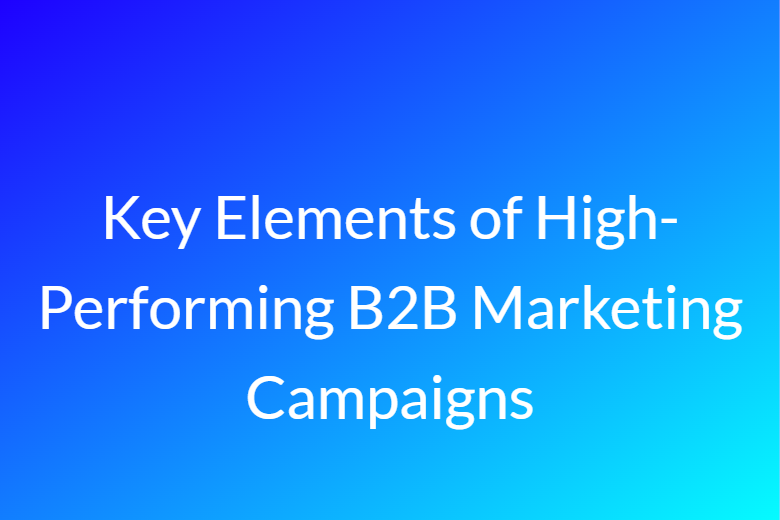High-performing B2B Marketing Campaigns don’t happen by chance they are the result of thoughtful planning, strategic execution, and data-informed optimization. With today’s buyers expecting personalized, value-driven interactions, marketers must combine creativity with precision to succeed.
This blog explores the essential elements that define impactful B2B marketing campaigns, revealing what separates industry leaders from average performers.
Buyer-Centric Campaign Planning
The foundation of any successful B2B marketing campaign is a deep understanding of the buyer. Marketers must go beyond demographic data and dive into behavioral and intent signals.
To build a buyer-centric campaign:
-
Develop detailed buyer personas based on job role, industry, and pain points
-
Analyze behavior through tools like intent data and CRM insights
-
Map content needs across each stage of the buyer journey
Buyer-centricity ensures every message is relevant, timely, and focused on solving real business challenges—hallmarks of effective B2B marketing campaigns.
Intent-Driven Targeting for Precision
Gone are the days of mass email blasts and generic outreach. Modern B2B marketing campaigns use intent data to identify which accounts are actively researching your solution.
With access to real-time signals—such as content consumption, topic searches, and competitor engagement—you can prioritize accounts most likely to convert.
Intent-based targeting, offered by platforms like Acceligize, enables marketers to:
-
Personalize outreach for high-intent leads
-
Deliver content aligned with current buyer interests
-
Reduce wasted ad spend by excluding low-intent audiences
Precision targeting drives higher engagement and conversion rates, making it a vital element of any successful B2B strategy.
Content Alignment with Buyer Journey
Not all content is created equal—and not all of it belongs at every stage of your funnel. High-performing B2B marketing campaigns design content that resonates with where the buyer is in their journey.
Here’s a quick breakdown:
-
Awareness Stage: Educational blogs, industry trend reports, and infographics
-
Consideration Stage: Whitepapers, product comparisons, and webinars
-
Decision Stage: Case studies, ROI tools, and free trials
Campaigns that use stage-specific content see better engagement and shorter sales cycles.
Seamless Sales-Marketing Collaboration
One of the biggest threats to B2B campaign performance is the disconnect between sales and marketing. When both teams are aligned, campaigns move faster, leads convert more efficiently, and pipeline quality improves.
Key alignment practices include:
-
Creating shared lead qualification criteria
-
Hosting regular campaign sync meetings
-
Using joint dashboards to track performance
-
Equipping sales with campaign messaging and enablement materials
Successful B2B marketing campaigns are cross-functional by design—sales and marketing should always move in lockstep.
Smart Use of Marketing Automation
Marketing automation tools play a critical role in managing complex, multi-touch campaigns at scale. From lead scoring to triggered emails, automation allows marketers to focus on strategy while technology handles the execution.
Benefits of automation in B2B marketing campaigns:
-
Personalized drip campaigns based on user actions
-
Real-time tracking of campaign engagement
-
Seamless CRM integrations for better sales handoff
-
Lead prioritization through behavior-based scoring
Automation isn’t just about efficiency—it enables smarter, more responsive campaigns that adapt to buyer behavior.
Multi-Channel Execution Strategy
Today’s B2B buyers are active across various platforms and devices. To reach them effectively, B2B marketing campaigns must embrace a multi-channel approach that meets prospects where they are.
A strong multi-channel campaign may include:
-
Email: For direct, personalized messaging
-
LinkedIn Ads: For professional targeting by role and industry
-
Display Retargeting: To re-engage past visitors
-
Syndicated Content: To boost visibility across high-authority platforms
-
Webinars and Virtual Events: For thought leadership and lead capture
The key is delivering a unified message across all channels while tailoring content formats to suit each medium.
Scalable Lead Nurturing Systems
Not every lead is ready to convert today. High-performing B2B marketing campaigns use structured lead nurturing sequences to build trust over time.
Effective nurturing includes:
-
Automated email workflows tailored to user behavior
-
Content libraries that support each decision stage
-
Retargeting strategies to maintain brand visibility
-
Progressive profiling to collect more lead data gradually
Lead nurturing moves prospects from interest to action by delivering value consistently and contextually.
Data-Driven Decision Making
Analytics should power every stage of your B2B marketing campaigns. Whether you’re choosing channels, testing headlines, or optimizing landing pages—data tells you what works and what doesn’t.
Important KPIs include:
-
Lead conversion rates by source
-
Email open and click-through rates
-
Cost per MQL and SQL
-
Sales pipeline contribution
-
Average deal velocity and value
Campaigns with robust tracking and analytics outperform those relying on gut instinct. Tools like marketing dashboards, heatmaps, and A/B testing platforms can provide insights to improve continuously.
Reusable Campaign Frameworks
One of the secrets behind consistently successful B2B marketing campaigns is repeatability. Campaign frameworks—documented strategies that can be adapted and reused—help scale efforts without reinventing the wheel.
These frameworks often include:
-
Persona-based email templates
-
Content maps by buying stage
-
Landing page wireframes
-
Reporting and attribution dashboards
-
Workflow automation sequences
Reusability reduces campaign launch time, ensures consistency, and increases campaign ROI over the long term.
Real-World Case-Driven Messaging
Abstract claims don’t move B2B buyers—real outcomes do. Campaigns that incorporate client success stories, benchmarks, and specific ROI figures build trust and increase conversions.
To add proof points to your campaigns:
-
Highlight quantifiable business results (e.g., “150% ROI in 3 months”)
-
Include industry-specific examples
-
Share client testimonials or video interviews
-
Use third-party validation or awards
Adding social proof enhances credibility and shows prospects that your solutions work in real-world scenarios.
Read the Full Blog Now @ https://acceligize.com/featured-blogs/impactful-b2b-marketing-campaigns-guide/
About Us
At Acceligize, we specialize in executing high-impact B2B marketing campaigns that identify and deliver Sales Qualified Leads to accelerate revenue growth across industries. Our data-driven methodology, powered by advanced intent analysis and personalized lead nurturing, ensures your sales team focuses on closing deals not chasing cold prospects. Through our end-to-end demand generation solutions, we connect you with the right decision-makers at the right time driving measurable results and enabling smarter, faster growth.
